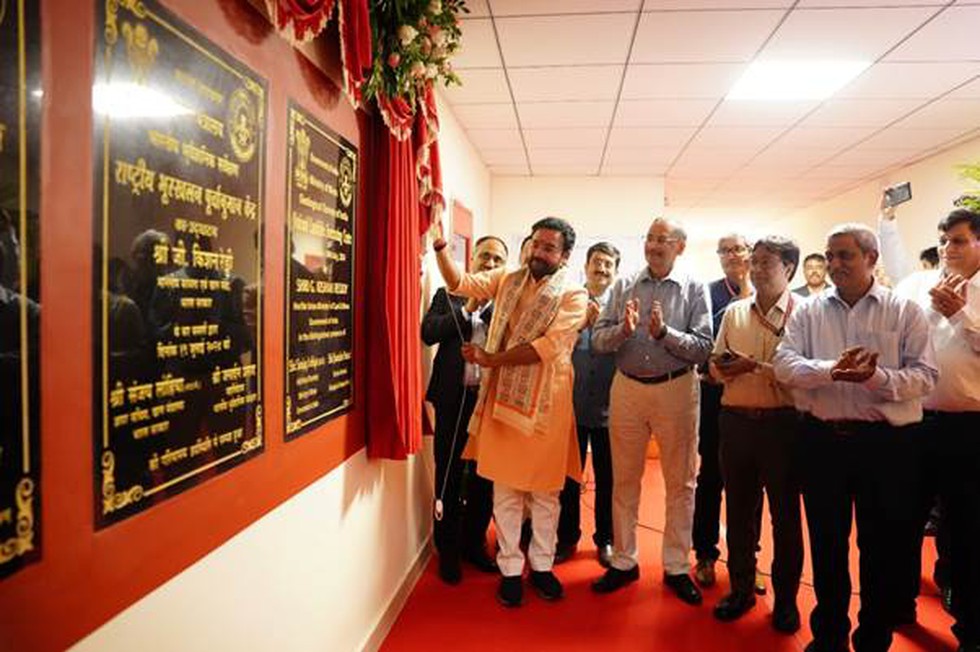Union Minister of Coal and Mines, Shri G. Kishan Reddy, inaugurated the National Landslide Forecasting Centre (NLFC) at the Geological Survey of India’s (GSI) Dharitri Campus in Salt Lake City, Kolkata. During the event, the Minister also launched the Bhusanket Web Portal and the Bhooskhalan Mobile App. The program was attended by dignitaries from various disaster management agencies, stakeholder organizations, the Director General of GSI, Shri Janardan Prasad, and other senior officials.
Objectives of NLFC
The NLFC is a pioneering initiative aimed at mitigating landslide hazards in India. The centre will provide live forecasting reports starting from July 20, 2024, benefiting residents of Kalimpong, Darjeeling, and Nilgiri districts. By 2030, the NLFC aims to operationalize the regional Landslide Early Warning System (LEWS) nationwide, issuing early warning bulletins for all landslide-prone states. Equipped with advanced technology, the NLFC will update landslide inventories and integrate real-time rainfall and slope instability data for enhanced forecasting accuracy.
Launch of Bhusanket Web Portal and Bhooskhalan Mobile App
The Bhusanket Web Portal is a significant step towards disaster risk reduction. It will disseminate relevant data and information on landslide hazards, initiating short-range and medium-range landslide forecasting in India. The Bhooskhalan Mobile App, integrated with the Bhusanket Web Portal, will enable quick dissemination of daily landslide forecasts and allow stakeholders to share and update information on landslide occurrences. The app is available on the Bhusanket Web Portal and will soon be on the Google Play Store.
Minister’s Address
In his address, Shri G. Kishan Reddy highlighted the critical role of GSI in disaster management, particularly in landslide hazard mitigation. He commended GSI officers for their dedication in establishing the NLFC and urged them to work towards fulfilling the nation’s mineral and disaster management needs, aligning with the vision of Aatmanirbhar Bharat and achieving Viksit Bharat by 2047.
GSI’s Commitment to Disaster Preparedness
The inauguration of the NLFC, and the launch of the Bhusanket Web Portal and Bhooskhalan Mobile App, are landmark achievements for GSI, demonstrating its commitment to advancing disaster preparedness and safety in India. These initiatives underscore GSI’s efforts to leverage technology and innovation for sustainable development, resource management, and disaster mitigation.
Review Meeting
Earlier in the day, the Minister visited the Geological Survey of India campus. At the Central Headquarters (CHQ) campus, he was welcomed by Director General, Shri Janardan Prasad, and chaired a review meeting to assess GSI’s ongoing activities and achievements. He emphasized GSI’s pivotal role in generating baseline data, augmenting the country’s mineral resources, and focusing on landslides.
Achievements and Expansion of GSI
GSI has expanded its focus from coal exploration to mapping rock types, geological structures, and exploring strategic and critical minerals. The number of exploration programs for critical minerals has increased from 127 last year to 196 out of 450 exploration programs this year. The successful launch of the National Geoscience Data Repository (NGDR) and the migration of the OCBIS portal to the OCI cloud are testaments to GSI’s commitment to innovation and efficiency.
History and Evolution
Established in 1851 primarily to find coal deposits for the Railways, the Geological Survey of India (GSI) has grown into a repository of geo-science information and a geo-scientific organization of international repute. Its main functions include creating and updating national geoscientific information and assessing mineral resources through various surveys and studies.
Core Competence
GSI provides geological expertise and geoscientific information essential for policy-making, commercial, and socio-economic needs. It systematically documents geological processes both on the surface and subsurface of the country and its offshore areas using the latest and most cost-effective techniques.
Organizational Structure
GSI is headquartered in Kolkata, with six regional offices located in Lucknow, Jaipur, Nagpur, Hyderabad, Shillong, and Kolkata, and state unit offices in almost all states. It functions as an attached office to the Ministry of Mines, enhancing its survey and mapping capabilities through the management and utilization of spatial databases.
Multiple Choice Questions (MCQs):
- What is the primary objective of the National Landslide Forecasting Centre (NLFC)?
- A. To provide live forecasting reports for earthquakes
- B. To mitigate landslide hazards in India
- C. To issue flood warnings
- D. To monitor volcanic activities
- Which web portal was launched alongside the NLFC by Shri G. Kishan Reddy?
- A. Bhusanket Web Portal
- B. Bhooskhalan Web Portal
- C. Disaster Management Web Portal
- D. Geological Web Portal
- By what year does the NLFC aim to operationalize the regional Landslide Early Warning System (LEWS) nationwide?
- A. 2025
- B. 2027
- C. 2030
- D. 2040
- What will the Bhooskhalan Mobile App facilitate?
- A. Dissemination of earthquake forecasts
- B. Sharing and updating spatial and temporal information on landslide occurrences
- C. Issuing tsunami warnings
- D. Providing weather updates
- Where is the Geological Survey of India (GSI) headquartered?
- A. Mumbai
- B. New Delhi
- C. Kolkata
- D. Chennai
